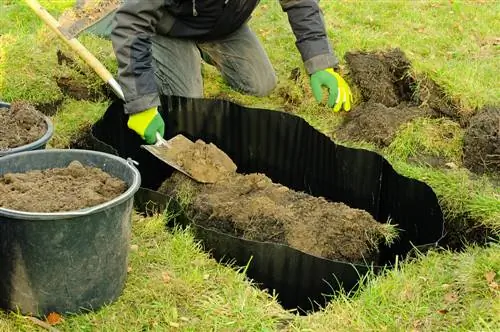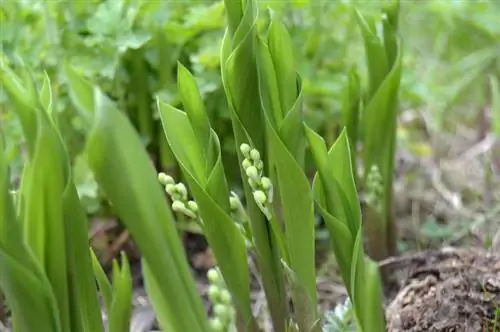- Author admin [email protected].
- Public 2023-12-16 16:46.
- Last modified 2025-06-01 06:02.
Bamboo doesn't think much of minimalist restraint in the garden. Many of its magnificent species and impressive varieties form strong runners, so-called rhizomes, which overgrow large areas within a short period of time. A rhizome barrier curbs growth and prevents bamboo invasion in the garden. The root barrier also keeps miscanthus and overgrown trees in check. Read this guide about what you should pay attention to when buying. You can find out how to properly install a rhizome barrier and what alternatives there are here.

- A rhizome barrier prevents runner-forming plants from spreading invasively in the garden.
- Rhizome barriers are made of 2mm thick HDPE polyethylene film to resist the root pressure of bamboo shoots.
- Hobby gardeners can buy a rhizome barrier from specialist retailers and install it themselves.
Buy rhizome barrier - tips on purchasing sources and products
Bamboo conquers its territory above ground and underground. The mighty stalks stretch up to 10 meters towards the sky. Under the surface, huge horizontal rhizomes spread out in all directions. To prevent bamboo roots from spreading uncontrollably, you should buy a rhizome barrier before planting and install it as a stable root barrier. The following overview summarizes which product properties need to be taken into account and where you can get rhizome barriers in the best quality at an affordable price:
Rhizome barrier - fundamental product properties
- Properties: frost-hardy, tear-resistant, UV-resistant, rodent-stable, pollutant-free, recyclable
- Material: High-pressure polyethylene (HDPE), metal (galvanized)
- Dimensions: from 70 cm wide and 2 mm thick
- Accessories: Locking rail
When taking measurements, please note that a rhizome barrier for bamboo must be installed at least to a depth of 60-65 centimeters. Furthermore, the barrier should protrude 5-10 centimeters. This is undoubtedly not particularly decorative, but it is strongly recommended. Root barriers that run flush with the garden soil allow the rhizomes to overcome them effortlessly.

A rhizome barrier only serves its purpose if it is absolutely tight and ends slightly above the garden floor
Shopping Sources with Price
When purchasing a rhizome barrier for bamboo and comparable green powerhouses, the focus is on high, stable quality. This requirement does not imply that you have to dig deep into your pockets for a root blocker that works. The following overview lists inexpensive purchasing sources for root barriers of the best quality:
- Mc-Bambus.de: Rhizome barrier made of HDPE film, 70 cm x 2 mm at a price from 7.50 EUR/m, 100 cm x 2 mm from 10.50 EUR/m
- Rhizomsperre.de: HDPE plastic sheets, 70 cm x 2 mm at a price from 14.90 EUR/m
- Bambusbörse.de: HDPE root barrier, 70 cm x 2 mm at a price of 66.90 EUR for 10 m, 114.90 EUR for 20 m
- Dehner: Polypropylene root barrier, 70 cm x 2 mm priced at EUR 26.99 for 3 m, EUR 42.99 for 5 m
- Hardware store (Obi, Hagebau, Hornbach): Plastic root barrier, 70 cm x 2 mm from 11.90 EUR/m
Matching locking rails are available from 27 EUR/piece. The rails are made of weather-resistant aluminum. Included in delivery are stainless steel screws and washers for secure attachment.
A metal rhizome barrier for bamboo represents - compared to plastic - a considerable investment. For this reason, standardized offers on the market are few and far between. Dimensions of 70 cm high, 2 mm thick and several meters long are considered custom-made, which results in significantly higher prices. Ideally, contact a metal company near you and request an individual offer.
Excursus
Rhizome barrier not obligatory for every bamboo
Numerous species and varieties come together within the bamboo family. Not everyone tends to grow extensive roots. For this reason, bamboo can be divided into 2 categories: Bamboo plants without runners with Fargesia in the name. Bamboo plants that form invasive roots and require a rhizome barrier. The latter can overgrow an area of 20 m² or more within a few years without a root barrier. Typical representatives of these bamboo growthers have Phyllostachys in their name. It also includes the varieties of arrow bamboo with the botanical name Pseudosasa japonica.
Installing rhizome barrier for bamboo - instructions for beginners

The best time to plant bamboo is in early spring. A date from mid/end of March is therefore ideal if you install a rhizome barrier beforehand or at the same time. As soon as the ground has thawed deeply, you can start installation. If you have missed the optimal time, plant the bamboo and rhizome barrier in the garden soil in autumn. Well-considered planning and the provision of the right tools set the course for the work to run smoothly. How to do it right:
Planning, material and tool list
The informed choice of the location for a bamboo with a rhizome barrier depends on several factors. Sunny to partially shaded lighting conditions as well as fresh, slightly acidic and loose, permeable soil guarantee he althy growth.
An area of at least 2 meters in diameter provides enough root space for a medium-sized solitary Phyllostachys bamboo. The rhizome barrier is sunk into the ground within a corresponding radius, from which the order quantity of the rolled goods can be calculated: 2 m diameter of the rhizome barrier results in a circumference of 6.3 m plus 20 cm for overlaps and 50 cm for offcuts. You can therefore purchase 7 m of rhizome barrier with a width of 70 cm, 90 cm or 100 cm as well as one or two suitable closure rails. The following work equipment should be available on the selected day:
- Bamboo Plant
- Rhizome barrier and closure rails
- Spade
- Cutter
- Inch ruler or tape measure
- Wooden sticks, string or similar marking material
- Work gloves
Ideally use a drainage spade. A spade with an unrolled shovel is also well suited for excavation work.
Installing rhizome barrier - instructions
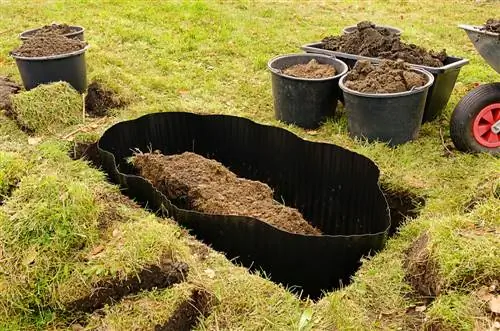
The rhizome barrier definitely has to survive something
Before you install a rhizome barrier, place the young bamboo in the container in a bucket of water. This allows the root ball to saturate with moisture, optimizing the starting conditions after planting. How to install a rhizome barrier correctly:
- Measure and mark the area around the planting pit
- First dig a 10 cm deep furrow along the marking
- Remove tag
- Dig a vertical trench 60-65 cm deep with a spade
- Remove sharp stones and old roots
- Insert the rhizome barrier into the trench with an overhang of 5-10 cm
- Close the beginning and end of the roll
- Fill in the trench and tamp the earth firmly
- Dig a planting pit in the middle of the island, pot and plant bamboo
- Important: The bamboo root disc is 10-15 lower than the upper edge of the root barrier
When closing a rhizome barrier, act according to the motto: Double stitching holds better. To do this, overlap the root barrier by 10 to 20 centimeters. Place an aluminum rail at the beginning and end of the track. This trick prevents roots from growing into the overlap.
Masonry bucket as a rhizome barrier alternative
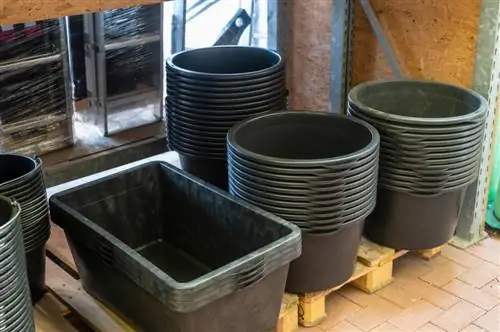
Masonry pots are a cheap, simple version of the rhizome barrier
If you prefer to build a bamboo rhizome barrier yourself, the bricklayer's bucket has proven to be an excellent alternative. At least you can put runner-forming dwarf bamboo in its place in this way. In order for a tub to fulfill its function as a root barrier to your complete satisfaction, important details are important. The following instructions explain, suitable for beginners, which properties characterize the ideal bricklayer's bucket and how to install it perfectly:
- Suitable mortar tub: from 65 cm high and 90 l capacity (can be purchased at hardware stores)
- Cut out the bottom with a cutter
- Dig a planting pit for the bamboo
- Insert the bottomless pot so deep that the edge of the container is 5 cm above the ground
- Fill the bricklayer rhizome barrier halfway up with loose, nutrient-rich bamboo soil
Please plant the potted, water-soaked dwarf bamboo so deep that its root disc is a few centimeters below the edge of the pot. Press the substrate with both hands and water generously. When deciding on a bricklayer's tub as a rhizome barrier, please keep in mind that even the largest tubs do not offer enough root space for a majestic flat-tube bamboo. For mini bamboo, raspberries or miscanthus, a mortar tub acts as an optional alternative to expensive rhizome barriers made of HDPE plastic.
Installing rhizome barrier subsequently - How does it work?
As a young plant, bamboo uses cunning and a few, seemingly harmless stalks to hide the fact that it has a concentrated load of growth power. Within a short time, the usurers strive to take over the entire garden area. Then the next step is to rigorously curb growth. By retrofitting a rhizome barrier, you are literally tackling the problem at the root.
If you want to remove tightly grown, woody bamboo rhizomes, you're fighting a losing battle with a hoe, spade and axe. Rent a mini excavator to dig a 90-100 centimeter deep trench around the bamboo stand. In advanced growth, a depth of 70 centimeters is usually no longer sufficient for a functioning rhizome barrier. Smooth out the pit walls by removing rocks and cutting off old roots. Sink the root barrier into the ground as explained in the instructions above.
Rhizomes outside the root barrier are cut through by the excavator. Of course, this does not mean the end of growth. In the following weeks, fresh stalks will sprout, which you should cut off consistently. It takes an average of 2 to 3 years for severed rhizomes to finally capitulate and stop growing.
Tip
Are you looking for a bamboo without a rhizome barrier for the front garden or as a privacy screen? Then Red Bamboo 'Chinese Wonder' is an excellent choice. As the botanical name Fargesia nitida suggests, the spectacular variety is one of the clump-forming bamboo species that does not allow invasive roots to grow.
Rhizome barrier mandatory - notorious usurers at a glance
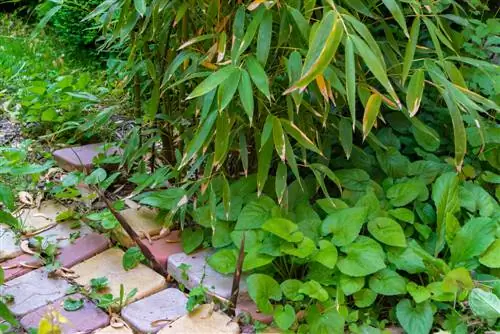
If flat cane bamboo is not contained, it will soon sprout up everywhere
Runner-forming bamboo species are not the only candidates for a rhizome barrier. Mother Nature has produced other plants that cause considerable headaches in the garden with massive root spread. The following table names notorious usurers that you should always plant with a rhizome barrier:
| Name | botanical name | well-known varieties |
|---|---|---|
| Flat tube bamboo | Phyllostachys | black bamboo, giant bamboo |
| Arrow Bamboo | Pseudosasa japonica | Japanese arrow bamboo |
| Dwarf Bamboo | Pleioblastus pygmaeus | Disticus, Pumilus |
| vinegar tree | Rhus typhina | Dissecta, fern fronds, deer butt sumac |
| Giant Miscanthus | Miscanthus giganteus | Aksel Olsen |
| miscanthus | Miscanthus sinensis | Silver Feather, Malepartus |
| Raspberry | Rubus idaeus | Polka, Prussia II |
| Sea buckthorn | Hippophae rhamnoides | Pollmix, Leikora |
Pampas grass is not a candidate for a rhizome barrier. The popular ornamental grass is actually making itself unpopular by spreading vehemently in the garden. However, the invasion is due to rampant self-seeding. A pampas grass sends countless seeds on their journey. You can put a stop to this bold venture by cutting flowering ears in good time, before the feathery seed heads form.
Check the rhizome barrier regularly
The best rhizome barrier is no guarantee that bamboo or giant miscanthus will escape sooner or later. Professional installation is therefore not enough if you want to maintain the upper hand in your garden. Please note a meticulous on-site inspection in your schedule at least once a year.
Armed with a spade, scissors or ax, cut off any suckers that venture beyond the root barrier. The earlier you put a stop to the escape attempt, the less effort it will take. For reasons of caution, we recommend keeping the inner edge of a rhizome barrier 20 to 30 centimeters wide free of runners.
Frequently asked questions
What is a rhizome barrier?
Numerous invasive plants spread in the garden through the predominantly horizontal growth of strong soil shoots, also called rhizomes. These include various types of bamboo, as well as giant miscanthus, raspberry bushes and the vinegar tree. A rhizome barrier limits root growth to a specific area and prevents unbridled spread.
Where can you buy rhizome barriers?
In order for a rhizome barrier to keep bamboo under control, high, stable quality is important. Only high-pressure polyethylene (HDPE) with a thickness of at least 2 millimeters is able to withstand the massive root pressure. The best sources for purchasing premium rhizome barriers are local specialist shops and competent online shops. What is sometimes offered in the hardware store as a rhizome barrier for bamboo or giant miscanthus often gives the gardener a headache afterwards. Weed fleece or pond liner are not suitable for long-term resistance to the enormous pressure of the rhizomes.
How deep do I have to install a rhizome barrier for bamboo?

A root barrier should reach at least 60cm deep
Rhizome barriers in tried and tested quality can be purchased in strips with a height of 70 cm. There's a good reason for that. You should install a root barrier to a depth of at least 60-65 cm. So that rhizomes of bamboo, miscanthus or other growths do not simply overcome the barrier above ground, a height of at least 5-10 cm above the ground is mandatory.
Can I install the giant miscanthus rhizome barrier later?
Subsequent installation of a rhizome barrier is possible, but it does involve a lot of work. First, all roots and rhizomes must be cut and dug out at the appropriate distance. This is exhausting because heavily woody runners are difficult to cut, even with an axe. Then dig a 60-65 centimeter deep trench around the giant miscanthus. Insert the rhizome barrier so that 5-10 centimeters protrude from the soil at the end. The ends of the strips should overlap by 10-20 centimeters and are connected with one or two aluminum rails. Finally, fill the trench back in.
How much planting area should the rhizome barrier cover for a Phyllostachys green cane bamboo?
As a rule of thumb, the following calculation has proven useful in hobby gardens: Half of the expected final height corresponds to the diameter of a rhizome barrier for bamboo. Based on a green cane bamboo with a final height of 5 m, you should install a rhizome barrier with a diameter of 2.50 m. This root space is sufficient for at least the first 10 years in a Central European garden.
We are planning a bamboo hedge as a privacy screen. What should you pay attention to when installing a rhizome barrier?
For a bamboo hedge, do not place rhizome barriers around each individual plant. Rather, the root barrier covers the entire hedge. Since the bamboo plants can spread laterally within a hedge, the width can be slightly narrower at 80 to 100 centimeters.
We would like to plant a bamboo grove to separate it from the neighboring property. How can we prevent the roots from growing to the neighbor?
First check with the responsible public order office about the required distance from the neighboring property. At this distance you can install a rhizome barrier made of sturdy HDPE film with a thickness of 2 mm and a depth of 70 to 100 cm. Plant the bamboo hedge at a distance of at least 50 centimeters from the root barrier. Please note that the rhizomes grow along the root barrier. This poses the risk that the extensions at both ends could extend into the neighboring property. Therefore, extend the rhizome film 2 to 3 meters back onto your property at each end of the hedge. In addition, check at least once a year whether the rhizomes remain behind the barrier.
We had to subsequently install a rhizome barrier on our flat tube bamboo. Now we are faced with a mountain of cut-off foothills. Where to put it?
Whether cut off, stabbed or dredged. Bamboo rhizomes don't think about stopping their growth so quickly if the connection to the mother plant is severed. For this reason, please dispose of the root residues in the trash can. If space is limited, transport the rhizomes to the local landfill or composting facility. The compost heap carries the risk that you will inadvertently spread viable root residues with the natural fertilizer in the garden.
Tip
Pruning its stalks does not curb the spread of flat-tube bamboo. When concerned gardeners vigorously prune an invasive bamboo, the ornamental grass responds by increasing growth of its underground rhizomes to compensate for the above-ground loss. A combination of rhizome barriers and occasional thinning cuts keeps growth well in check.

